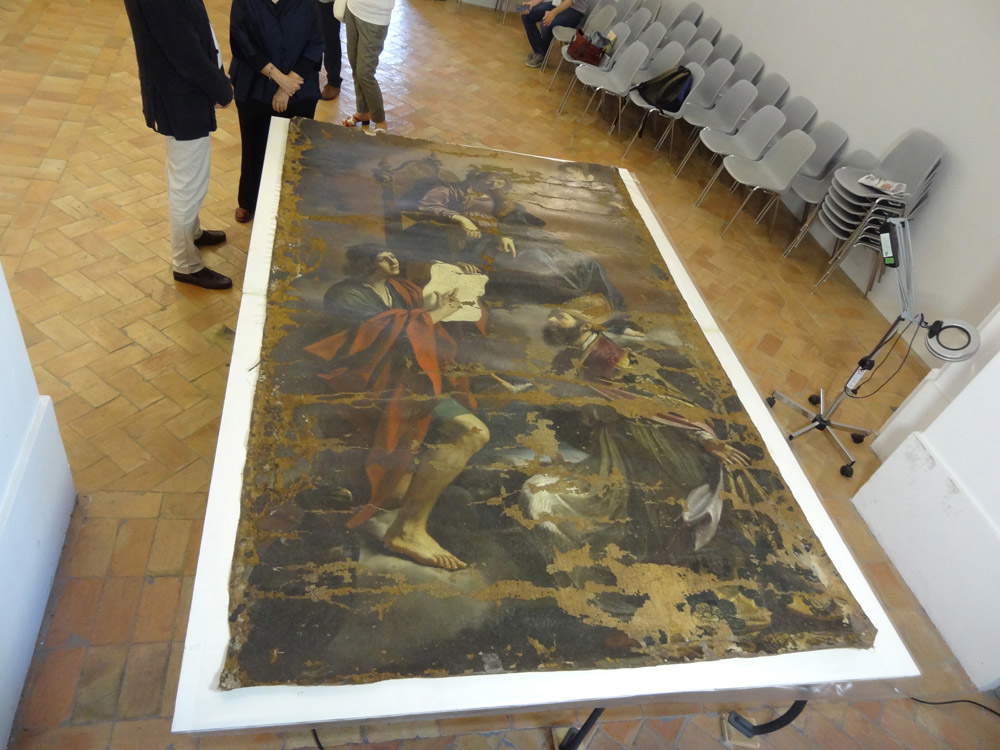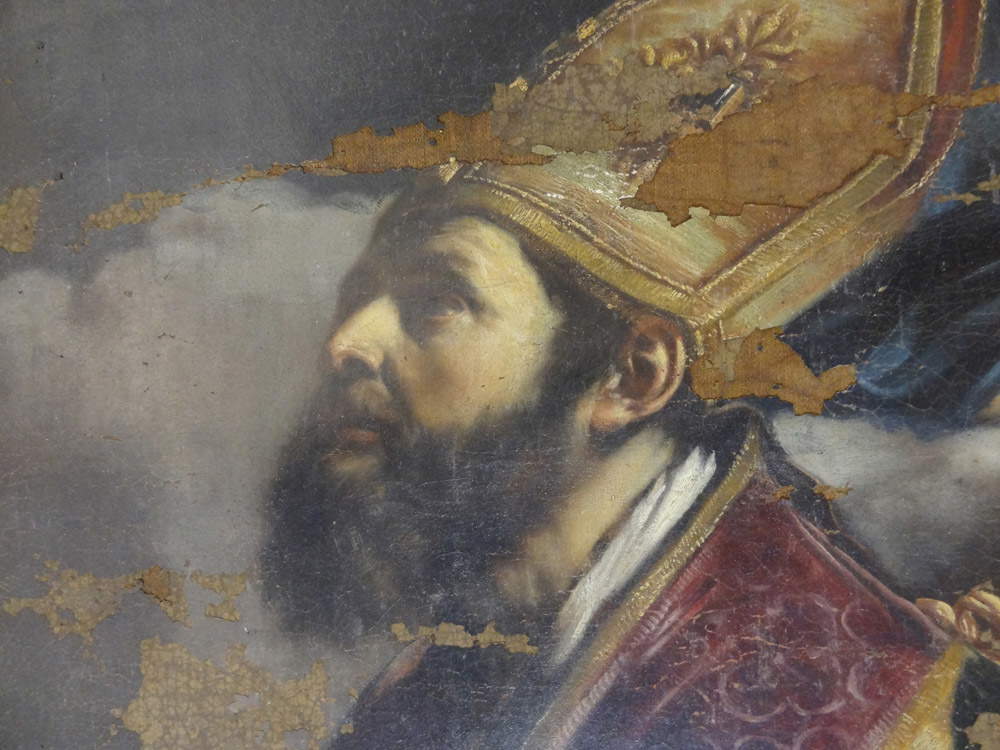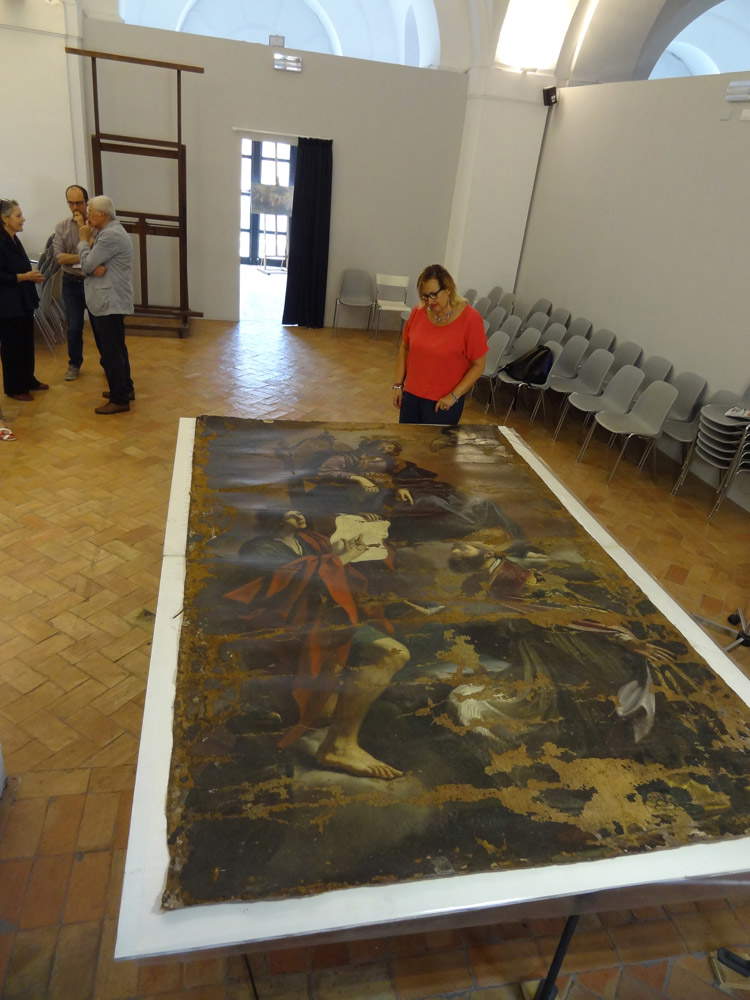The Madonna with Saints John the Evangelist and Gregory the Wonderworker, the painting by Guercino stolen from the church of San Vincenzo in Modena in 2014, recovered in February this year in Morocco and returned to Italy in mid-July, will undergo a restoration that will have to compensate for the very heavy damage the canvas suffered as a result of the theft. Last July 31, we interviewed Maria Grazia Gattari, conservation restorer officer of the Soprintendenza archeologia belle arti e paesaggio for the metropolitan city of Bologna and the provinces of Modena, Reggio Emilia and Ferrara (she will be in charge of evaluating the restoration project forwarded by the Istituto Superiore per la Conservazione e il Restauro, instructing the authorization file, dealing with high supervision and directing the restoration in all its phases), and we spoke with her about the damage suffered by the work and the interventions it will undergo in the coming months.
 |
| Guercino, Madonna and Child with Saints John the Evangelist and Gregory the Wonderworker (1629-1630; oil on canvas, 293 x 184.5 cm; Modena, San Vincenzo) |
What kind of damage did Guercino’s canvas suffer?The canvas painting was cut from its frame with a cutter, scalpel or similar sharp instrument, in particular it was trimmed around its perimeter just flush with the frame, which was never found again and was probably destroyed. The work was then rolled up into a mat with the painted part facing inward, and this operation, very detrimental to the proper preservation of the artifact, caused numerous cracks in the pictorial film, in several places, resulting in the detachment of pieces of mestica(note: layer of matter, usually plaster and animal glue, applied to the canvas or board support to obtain a uniform surface and suitable to receive pigments according to the painting technique adopted) and polychromy ,of various extensions, occurred at the time of unrolling. An operation carried out perhaps to preserve the work from damage while making it easier to transport the loot. In reality, this procedure enacted an invasive and highly destructive action, as it caused damage to the preparation of the pictorial film, with the obvious loss of a large part of the decoration, which was shattered. The damage is therefore extensive, not least because, evidently, the painting has been rolled up for a long time and has been repeatedly opened and resealed without due attention to the recovery and relocation of the detached fragments.
There is even talk of 30 percent of the surface area being damaged... We made an eyeball estimate: in fact, the amount of damaged surface area is perhaps even more than that 30 percent initially stated. Because we are talking, as mentioned, about the polychromy but also about the mestica: if you look at the painting, you will notice that the damage is extensive to the point that, in some parts, you can directly discern the original supporting canvas. In short, the lesions and gaps are the result of lifts so deep and wide that the original support is exposed. The artifact, in turn, has undergone previous restorations precisely in 1965 and 1990: in 1965, in particular, it was re-lined, with double lining, as was the practice at the time for almost all paintings entering restoration workshops. This operation was carried out automatically without regard to whether the support needed re-lining because its condition was precarious or damaged, but mainly to keep the canvas more in tension, simply for an aesthetic effect: this is a very important detail since this type of intervention,now obsolete if not necessary due to the precarious condition of the support, greatly affected the conservation of the artifact when it was transported following theft. The increased stiffness due to the double lining, in fact, meant that the pictorial film and its preparation, in the most fragile areas, perhaps in the retouched areas or in the perimeter edges, blew off more easily when the painting was rolled up after being removed from the church of St. Vincent. Probably if the work had not been re-lined, moreover double-lined, the damage would surely have been less extensive and extensive.
 |
| The damage on the Guercino painting. Photo courtesy of Maria Grazia Gattari |
 |
| The damage on the Guercino painting. Photo courtesy of Maria Grazia Gattari |
 |
| The damage on the Guercino painting. Photo courtesy of Maria Grazia Gattari |
Have preliminary analyses already been carried out on the painting?Right now we are only in an exploratory phase: the painting returned from Morocco in July, and I carried out a preliminary inspection to ascertain only the conservation status of the work, since the painting comes from our territory and therefore must follow liter of authorization required by Article 21 of the Cultural Heritage Code. As of today, I am waiting to receive the restoration project from the Istituto Superiore per la Conservazione e il Restauro in Rome to whom the task has been entrusted, a project that will be evaluated and will follow the normal practices for restoration work on protected works. It will then proceed with the diagnostic investigation phase: in particular, it will be possible to use the numerous fragments of polychromy and detachments of texture that have been found inside the painting. Some of them will be able to be relocated, although with great difficulty, while the most minute ones will be optimized in order to conduct analysis and deepen the pictorial techniques of Guercino, after which we will proceed with the technical-scientific restoration intervention phases. The major observations will be those aimed at understanding how to be able to reconstruct what was lost through the recovery of archival photographic documentation related to the work prior to the theft. The intervention that we are going to carry out today is that of recovery and reconstruction of the work in its accidental deterioration since it has been well preserved and has always had, over time, a careful and punctual maintenance, and it had recently been exhibited at an exhibition at the Reggia di Venaria Reale, in 2014. I am sure that on that occasion the painting was loaned out after a careful assessment analysis of its state of preservation. Having finished the phase of investigation of the constituent materials to recompose the gaps with similar or compatible products, we will proceed to the removal of the recoating that has greatly stiffened the canvas and has resulted in craquelure and considerable lifting having first carried out the operation of mapping and veiling of the front and the recovery of selected fragments that will be relocated contemporanemante phase of consolidation of the paint film to proceed to the reconstruction of the missing decoration with suitable methodology(note: veiling is a protective operation and is often carried out before removing a painting in need of restoration, so as to prevent part of the pictorial film from detaching and being lost in the course of handling and subsequent operations. The procedure consists of spreading adhesive on the pictorial film, compatible with the original and easily removable, protected by special papers, called Japanese papers or rice papers, which are not subject to shrinkage and have a high degree of absorption).
At the end of the restoration, how will the work look? Will the gaps be restored? Of course, we cannot leave the gaps empty. A very talented work like this must be reconstructed to give the proper reading as a whole. Fortunately, the missing parts did not affect the faces: none of the faces of the figures that make up the painting were affected by lacerations or color falls. This is a relevant fact because the expressiveness of a face corresponds to the artist’s intentions , a kind of emotional communication and its reconstruction generates a personal interpretation even in pure imitation, although we have an in-depth photographic documentation of the painting before the theft and one could, if one wished, reconstruct everything with great precision. However, this is not the point: it is necessary to maintain and preserve the original by applying the correct scientific-technical restoration methodology even if the intervention is not about a restoration due to the deterioration of the artifact due to time but to damage caused accidentally by human work.
Have you already planned timelines for the completion of the work?My desire is to return the painting to San Vincenzo within a year, and I hope that the work can be completed by then. The property and the city of Modena very much want their Madonna Enthroned to return home soon: this is a community that is very attached to its cultural heritage and has a deep love for its territory, and I will do everything I can to get the work back as soon as possible. Of course, this does not exclude that the work be carried out in accordance with the rules at a school of high training such as the Istituto Superiore per la Conservazione e il Restauro, and I will not fail to follow step by step and in depth all the interventions approved by this Superintendency, which will not have to be timely simply because the work must return home soon. On the contrary, the interventions will have to be meditated: we will make punctual and in-depth evaluations together with the Superior Institute for Conservation and Restoration to understand how to set up the work, which is still in the early stages, since I have yet to receive the project, which is why we have not made any decisions at the moment. However, I will be diligent in evaluating and approving the project: for my part, I guarantee maximum cooperation and availability. I cannot give definite timeframes, but I believe that within a year, a year and a half, the work can come home, however it will be a topic to be addressed at the next inspection. It is a goal we want to give ourselves and we will do our best so that it can really be achieved.
Warning: the translation into English of the original Italian article was created using automatic tools. We undertake to review all articles, but we do not guarantee the total absence of inaccuracies in the translation due to the program. You can find the original by clicking on the ITA button. If you find any mistake,please contact us.